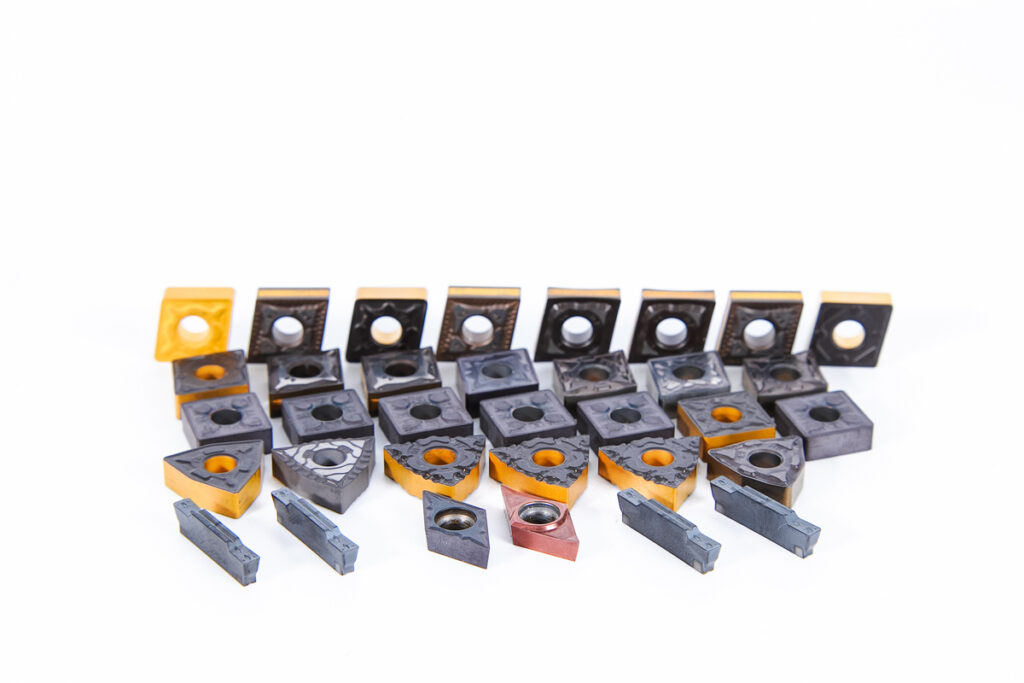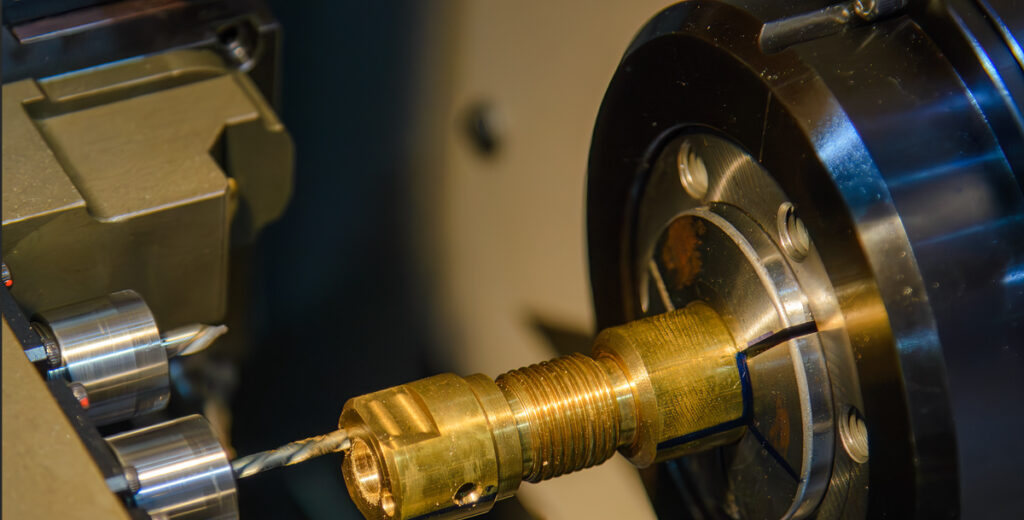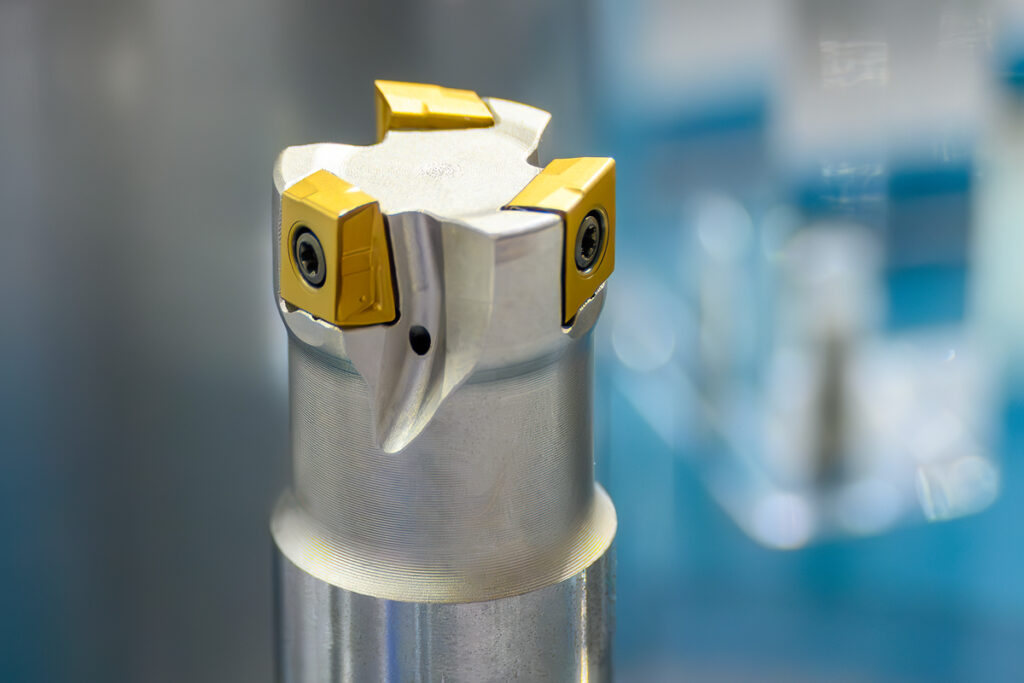Introduction – Molded vs Ground Inserts
In CNC machining, with all the different types of turning inserts, selecting the right insert type is crucial to achieving optimal performance, efficiency, and cost-effectiveness. Most types are available in both molded vs ground inserts. For example, the difference between CNMG and CNGG lies in the third letter of the code, which indicates molded vs ground inserts.
Ground inserts, while more expensive, are ideal for applications requiring tight tolerances and high precision, making them the go-to choice for industries like aerospace and medical devices. On the other hand, molded inserts are generally more affordable and are well-suited for tasks involving more open tolerances or high-volume machining, where exact dimensional accuracy is not as critical.
Key Differences Between Molded and Ground Inserts
At a high level, molded inserts are made using a molding process, resulting in rougher finishes and looser tolerances compared to ground inserts, which undergo additional grinding to achieve precise dimensions and smooth finishes. The most significant distinction between the two insert types lies in their manufacturing tolerance.
Molded inserts have a larger manufacturing tolerance, meaning the part size can change more drastically when switching between different molded inserts. On the other hand, ground inserts are precisely ground to a tight tolerance, ensuring that when an insert is swapped out, the part dimensions remain more consistent, which reduces the need for adjustments and offsets.
This inherent precision with ground inserts leads to fewer human errors, less scrap, and a more efficient machining process. Understanding turning inserts types is crucial when it comes to efficient manufacturing.
1
Understanding Turning Insert Codes: Molded vs. Ground Turning Insert Types
To understand how the difference between molded and ground inserts impacts CNC machining, it’s essential to know what the turning insert codes mean. In the insert code, the third letter is often indicative of whether the insert is molded or ground.
- Ground Inserts: These inserts are typically denoted with a G in the third position of the code (e.g., CNGG, VNGG, WNGG). The “G” signifies that the insert is ground, meaning it has undergone additional grinding to achieve a smoother finish and tighter tolerances.
- Molded Inserts: On the other hand, inserts with an M in the third position (e.g., CNMG, VNMG, WNMG) are typically molded inserts. The “M” indicates that the insert is molded, meaning it has a rougher finish and is manufactured with slightly less precision.
This distinction in turning insert codes is crucial for machinists to understand when selecting molded vs ground inserts, as it directly impacts the level of precision and the need for adjustments during setup and operation.
2
Manufacturing Tolerance: The Core Difference of Molded vs Ground Inserts
One of the most significant differences between molded vs ground inserts is their manufacturing tolerance. Molded inserts typically have a tolerance of ± .005″ (± 0.127 mm), while ground inserts are manufactured to a much tighter tolerance of ± .0002″ (± 0.005 mm). This tighter tolerance in ground inserts ensures that the cutting edge, including the nose radius, sits precisely in the same position every time it’s installed into the tool holder.
In contrast, molded inserts, with their larger tolerance, can vary by as much as ± .005″ (± 0.127 mm), meaning the insert may sit in a slightly different position each time it’s replaced. This variance makes molded inserts less repeatable compared to ground inserts, where the consistent positioning results in greater accuracy and repeatability, crucial for high-precision applications.
Real-World Example:
Imagine an operator is running a batch of parts and needs to replace a CNMG molded insert. With molded inserts, due to the looser tolerances, the new insert may require the operator to back off the offset on the CNC machine before running the first part. If this step is missed or incorrect, it could result in scrap or dimensionally incorrect parts, leading to significant waste and rework. Additionally, adjusting the offset after every insert change can be time-consuming, reducing overall efficiency.
In contrast, when switching to a ground insert, the operator typically does not need to back off the offset when replacing the insert. The tight manufacturing tolerances of ground inserts ensure that the new insert is nearly identical in terms of cutting edge position, making it much easier to maintain consistent part dimensions without requiring extensive adjustments. This results in faster setups, reduced human error, and greater overall efficiency in production.
3 Benefits of Molded Inserts
Cost-Effective for High-Volume Production
Molded inserts are typically less expensive due to their simpler manufacturing process. For applications where precision is not as critical, such as in high-volume production or rough machining, molded inserts offer a cost-effective solution. The savings in material and manufacturing costs can significantly reduce overall production costs. Molded inserts are generally used for roughing operations, where the goal is to remove material quickly and efficiently without the need for precise dimensions.
Ideal for Softer Materials
Molded inserts are also well-suited for softer materials or less demanding applications. They provide good performance in general-purpose machining, especially in industries like automotive and general machining, where exact tolerances are not always necessary.
4 Disadvantages of Molded Inserts
Lower Precision and Increased Setup Time
The larger manufacturing tolerance of molded inserts makes them unsuitable for high-precision work. In applications where dimensional accuracy is critical, molded inserts can introduce variability in part sizes, leading to increased scrap rates and longer setup times. As mentioned, switching to a new molded insert can require adjustments to offsets, increasing the potential for human error.
5 Benefits of Ground Inserts
High Precision and Consistency
Ground inserts are manufactured with tight tolerances and provide excellent consistency between insert changes. When using ground inserts, the operator is less likely to encounter issues with part dimensions, making them ideal for precision machining and industries such as aerospace, medical devices, and electronics. The precision of ground inserts helps ensure that parts meet the required specifications consistently, reducing the risk of dimensional errors and scrap. Ground inserts are typically used for finishing operations on parts where tighter tolerances and more critical dimensional accuracy are required.
Faster Setup and Less Human Error
The primary benefit of ground inserts in terms of human efficiency is that they allow operators to switch inserts without needing to back off the offset. This results in quicker setups and reduced chances of mistakes during production, which is especially valuable in high-precision machining where quick adjustments can lead to substantial cost savings.
6 Disadvantages of Ground Inserts
Higher Cost
One significant disadvantage of ground inserts is their higher cost. The additional grinding process adds to the manufacturing time and complexity, making ground inserts more expensive than molded inserts. This added cost can be a concern for companies that prioritize cost efficiency over precision, particularly for less demanding applications.
Not Ideal for High-Volume, Low-Precision Machining
While ground inserts are excellent for precision work, they are often not ideal for high-volume machining where cost control is critical. The additional processing time required for grinding can make them less economical for applications where precision is not as important.
7
Which Insert to Use: Molded or Ground Turning Inserts?
Use Molded Inserts When:
- Cost is a significant factor, particularly in high-volume production.
- Precision requirements are not strict, and dimensional variability can be tolerated.
- Working with softer materials where durability and precision are less critical.
Use Ground Inserts When:
- High precision and tight tolerances are essential, such as in aerospace, medical devices, or electronics.
- Reducing setup time and human error is a priority.
- Consistent part dimensions are critical across multiple insert changes.
Camco Precision Machining: Experts in CNC Machining and Insert Selection
At Camco Precision Machining, we are experts in selecting and utilizing the right turning insert types for every machining application. With extensive experience in both molded vs ground inserts, we ensure that the right insert is chosen for each unique project, balancing precision and cost-efficiency to meet our clients’ specific needs.
Whether you’re working on high-volume production or requiring high-precision parts, our team is equipped to provide expert guidance and top-quality machining services. Request a quote today for your CNC machined parts and experience the Camco difference in quality and efficiency.



